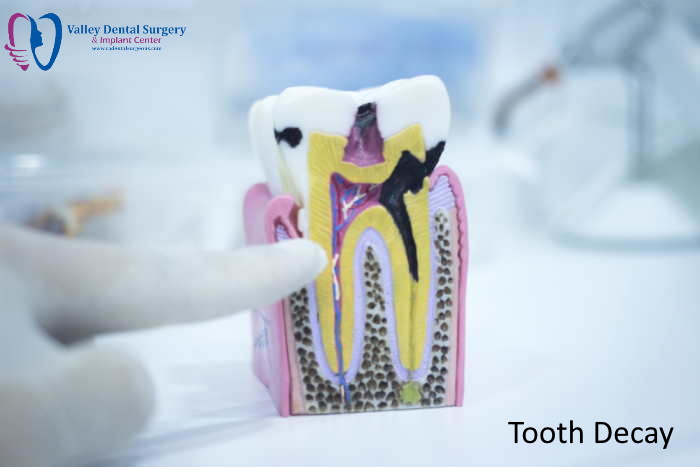 Damage to the surface of a tooth, also known as the enamel, is referred to as tooth decay. It occurs because bacteria in your mouth produce acids, which then destroy the enamel of your teeth. According to the Journal of Dental Research, the fillings have a potential lifespan of somewhere between seven and ten years. Valley Dental Surgery & Implant Center, Dr. Hani Jamah‘s 22 of years experience in the treatment of tooth decay. Our dental office is located near Santa Rosa, California.
Damage to the surface of a tooth, also known as the enamel, is referred to as tooth decay. It occurs because bacteria in your mouth produce acids, which then destroy the enamel of your teeth. According to the Journal of Dental Research, the fillings have a potential lifespan of somewhere between seven and ten years. Valley Dental Surgery & Implant Center, Dr. Hani Jamah‘s 22 of years experience in the treatment of tooth decay. Our dental office is located near Santa Rosa, California.
We are located nearby; please get in touch with us if you have any inquiries regarding the treatment of tooth decay in Santa Rosa, California or call (707) 532-2441 to set up a meeting or appointment.
Tooth Decay Treatment by Dr. Hani Jamah
With Dr. Hani Jamah’ significant knowledge in the treatment of tooth decay, he will guide you through the steps necessary to ensure that your teeth are safeguarded against caries. Dr. Hani Jamah, a tooth decay Santa Rosa expert, provides free consultations to help decide the most effective course of treatment as well as the associated costs nearby Santa Rosa.
What is Tooth Decay?
Tooth decay is caused by an accumulation of germs that has been allowed to go untreated for an extended period of time. Your teeth will suffer surface damage as a result of this. Because cavities are so common in children, it is essential to instill in them a healthy oral hygiene routine as early as possible in order to protect their teeth and gums.
What is The Appearance of Tooth Decay?
When tooth decay is in its earliest stages, it may manifest itself as a white spot on the tooth. If there is a darker region or a hole in the tooth, this may be an indication of more severe decay.
What Is The Cause of Tooth Decay?
Acid is produced by plaque when it builds up on your teeth, which is the first step in the decaying process. When plaque is allowed to build up, it can lead to a variety of other dental problems, such as dental caries, which are holes in the teeth, gum disease, and tooth abscesses.
What are the Symptoms of Dental Decay?
- toothache – Toothaches are one of the most prevalent, if not the most common, signs of, tooth decay. They keep you up with excruciating pain that is constant and does not have a clear explanation.
- Bad breath – This condition is brought on by germs that live in and around your teeth and gums.
- Discoloration – There are brown, black, or gray patches on your teeth.
- tooth sensitivity – Tooth sensitivity occurs when a person experiences soreness or pain as a result of eating or drinking anything that is either too hot or too cold, too sweet, or too acidic.
What are the Stages of Tooth Decay?
Tooth decay can develop quickly and cause serious problems if not treated promptly and prevented by practicing good dental hygiene. Many people with advanced dental decay require surgical tooth removal, and many of them have additional problems, such as infection.
Stage 1: Initial demineralization
After being subjected to the acids that plaque bacteria produce, the enamel of a tooth will begin to lose its mineral content. When this occurs, a white spot will begin to form on one of your teeth, and you will be able to see it. The first sign of tooth decay is the loss of minerals in this region, which indicates that decay has already begun.
Stage 2: Enamel decay
The condition of the enamel will continue to worsen. It is possible for a white spot on a tooth to change color and become brown. As the enamel on your teeth thins, you run the risk of developing cavities or even tiny holes.
Stage 3: Dentin decay
When decay reaches the dentin in your teeth, you may start to experience sensitivity in those teeth. It’s possible that you’ll experience this, especially while consuming hot or cold meals or beverages.
Stage 4: Pulp damage
In the event that the pulp is injured, it may develop an inflammation and start to swell. Because they are unable to grow to accommodate the swelling, the surrounding tissues in the tooth may apply pressure to the nerves. This can cause the nerves to become inflamed. It’s possible that this will cause pain.
Stage 5: Abscess
When tooth decay reaches the pulp of the tooth, there is a greater chance that bacteria will enter the pulp and cause an infection. As a consequence of increased dental inflammation, you run the risk of developing an abscess, which is a pus-filled pocket that forms at the root of your tooth.
When cavities in the teeth become infected with abscesses, the patient may experience terrible pain that radiates to the jaw. A fever, enlarged lymph nodes in the neck, and swelling of the gums, cheeks, or jaw are some of the other symptoms that may be present.
Why are my molars rotting at the gum line?
Plaque tends to accumulate more quickly in particular areas. Plaque and gaps between teeth, for example, thrive in the grooves and pits of the molars. Plaque can also gather fast along the gumline, and if this plaque is not removed, a gumline cavity will form.
How Can Tooth Decay be Treated?
Do Fluoride Treatments remove decay from tooth?
- Fluoride treatments – Your tooth enamel can be restored or tooth decay can be repaired with the aid of a fluoride treatment. It has the potential to stop the progression of a cavity in its very first phases.
Can Fillings fix a tooth with decay?
- Fillings – When deterioration has advanced past its first stages, it is assisted in being removed by dental fillings.
Do Crowns restore rotting teeth?
- Crowns – Repairs teeth whose caries have progressed to an advanced stage.
Should I get a Root Canal for my decayed tooth?
- Root canals – Repairs and preserves the life of a severely damaged or infected tooth so that it does not need to be removed.
Is a Tooth Extraction a good option for fixing decayed teeth?
- Tooth extractions – This oral surgery removes microorganisms when a tooth becomes infected, injured, or decaying beyond repair.
Can a Decayed Front Tooth be reversed?
Reversing tooth decay is curable if caught early. Just early tooth decay, when it has only affected the enamel, is curable. It is impossible to repair dental decay after it has pierced the enamel and reached the softer core of the tooth.
How to relieve pain from a tooth with decay?
To treat tooth decay discomfort, take an OTC anti-inflammatory such as Advil, Tylenol, eugenol, or Aleve. Avoid foods and beverages that are spicy, cold, sweet, or acidic. Brush and floss gently to keep the region clean.
Make an Appointment with Dr. Hani Jamah
* FREE Digital X-rays ($150 Value)
* FREE New Patient Consultation ($100 Value)
* We Maximize your Insurance, so you pay less out of pocket.
Dr. Hani Jamah at Valley Dental Surgery & Implant Center offers the highest level of dental treatment at a price that our neighbors near Santa Rosa can afford. Call us at (707) 532-2441 to schedule an appointment.
Affordable Tooth Decay Treatment Near Me in Santa Rosa, California
Looking for Dental Decay treatment Near Me? See our dental office location and directions. Tooth decay treatment near Santa Rosa is guaranteed affordable, and we will guide you through the entire process.
